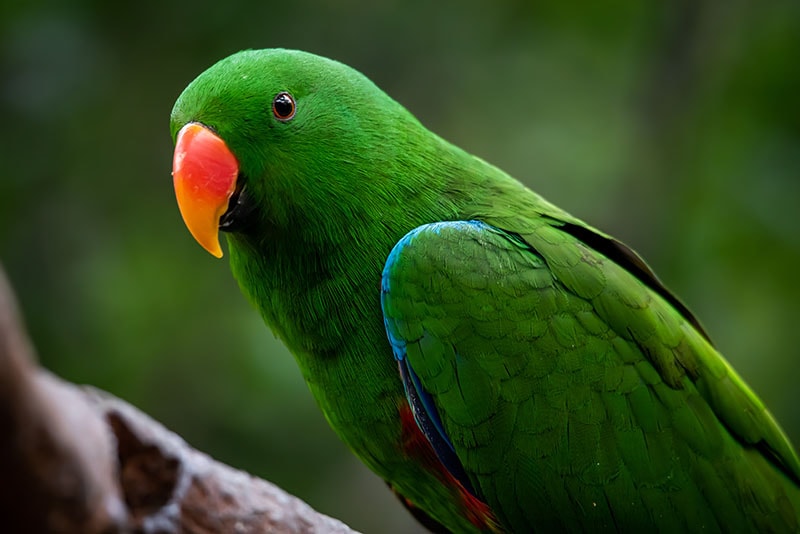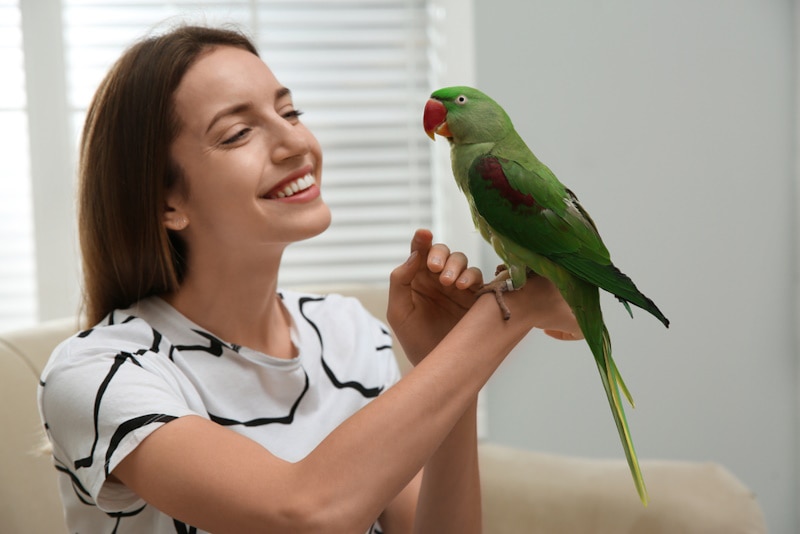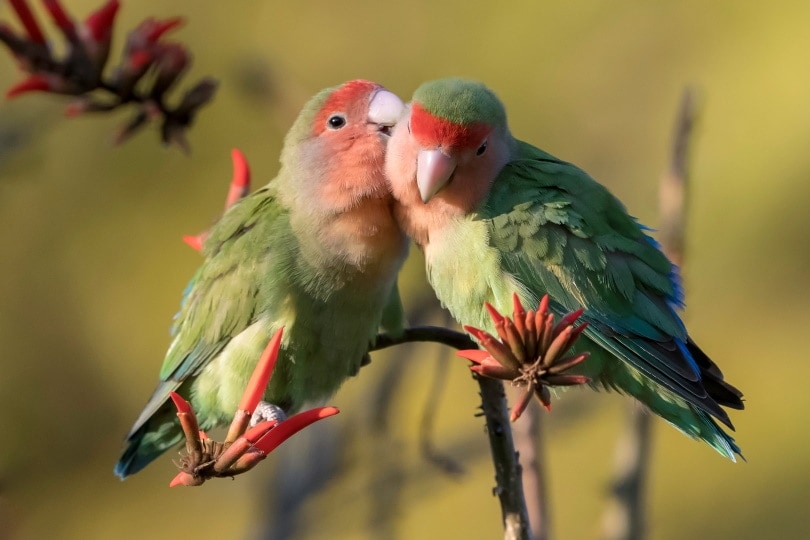15 Types of Tropical Pet Birds & Where They Can Live (With Pictures)
Updated on
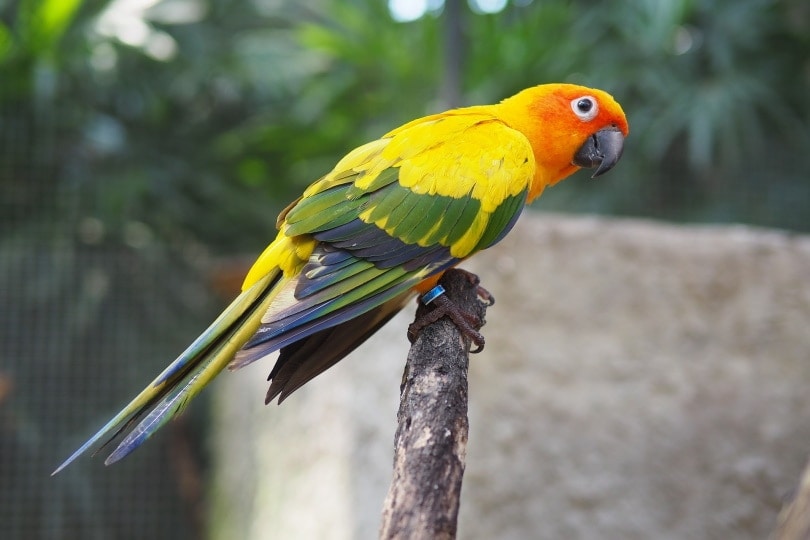
Even though they’re not cuddly like a dog or cat, many people enjoy having birds in their homes. According to the American Pet Products Association (APPA)1, about 6.1 million American households have at least one avian member. Birds have always held a mystique for humans with their ability to fly. However, they bring something new to the mix that other animals cannot: the ability to talk.
While many species have a limited repertoire, others, like the African Grey Parrot, have an incredible vocabulary that puts them in a class of their own.
The 15 Types of Tropical Pet Birds & Where They Can Live
1. Australian Zebra Finch

| Geographic Range | Australia |
| Size | Small |
| Care Level | Easy |
The Australian Zebra Finch prefers dry grasslands and savannas in its native land. They are year-round residents on the continent, forming small social groups. They are popular pets because they’re so easy to raise and breed. The species isn’t one you’ll likely handle. Instead, they’re best enjoyed in a flock where you can watch their interactions and listen to their melodious chatter.
The Australian Zebra Finch lives only about 5 years. It thrives on a high-quality seed mix, which you can supplement with treats, like fruits, vegetables, and egg food.
2. Domestic Canary
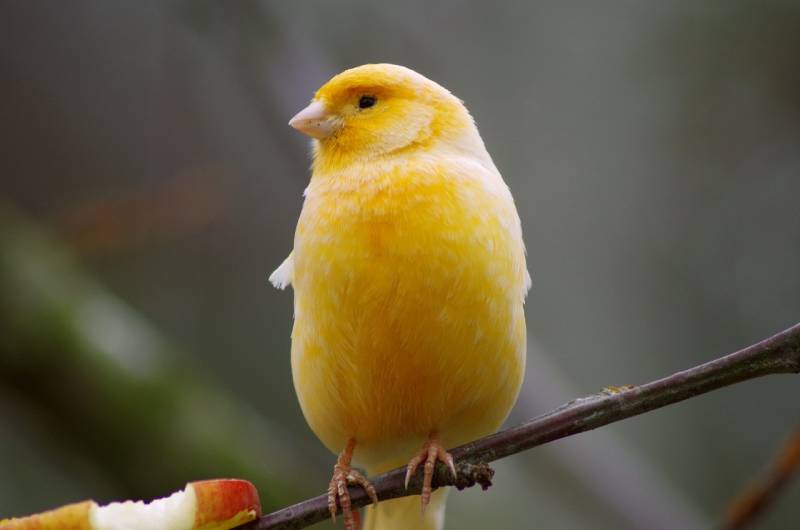
| Geographic Range | Macaronesian Islands |
| Size | Small |
| Care Level | Easy |
The Domestic Canary hails from the Macaronesian Islands in the North Atlantic Ocean. It still lives overseas despite its presence in the pet trade. Enthusiasts have selectively bred it into many color variations, including the classic yellow, brown, red, and bronze. You’ll also find birds with different songs but nevertheless beautiful expressions.
The male is the gifted singer, beginning at around 6 months when he reaches sexual maturity. Like the Australian Zebra Finch, the Domestic Canary isn’t a bird you handle. Its song is where it shines as a pet and as a welcome addition to your household.
3. Budgerigar (Parakeet)

| Geographic Range | Australia |
| Size | Small |
| Care Level | Easy |
The Parakeet belongs to the parrot family like the other larger species on our list. It is an excellent beginner bird for those who want a pet that is more hands-on than our first entries. It is another Australian species with introduced populations in the United States and Puerto Rico. Unsurprisingly, its wild population is increasing.
The Wild Parakeet is a smaller and drab-colored bird compared to the color variations from selective breeding. It’s a friendly and active pet that lives in large flocks in its native land of Australia. It responds well to handling, especially if you start when it’s young. It does best if you devote playtime to it. You can also keep them in pairs or small groups.
4. Peach-faced Lovebird

| Geographic Range | Southwestern Africa |
| Size | Small |
| Care Level | Easy |
The Peach-faced Lovebird is one of a few species that has found a home in the pet trade. It’s appropriately named because of how strongly it bonds with its mate. It’s a parrot similar to our last entry, although it’s still on the smaller side. It lives in the savannas of Africa in South Africa, Botswana, Namibia, and Angola. Introduced birds also call Puerto Rico home.
The Peach-faced Lovebird has a more varied diet than other species we’ve considered. It eats seeds but will also feed on fruits and vegetables. This bird likes to fly, making an aviary a better choice for a cage, preferably with a lock. It is a friendly pet if you handle it daily.
5. Gray Cockatiel
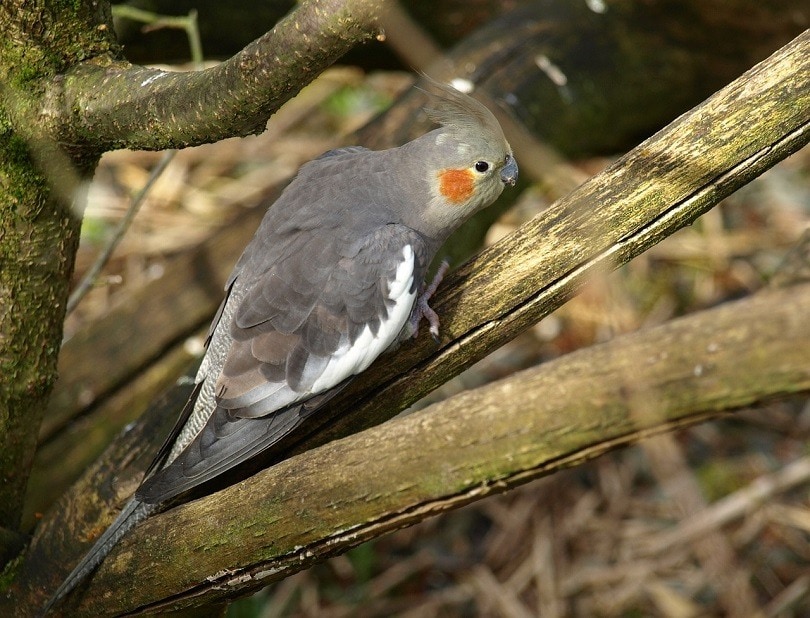
| Geographic Range | Australia |
| Size | Medium |
| Care Level | Easy |
The Gray Cockatiel is another Aussie bird, which is an excellent step up from a Budgerigars. It is an active and lively bird that is sure to prove an entertaining addition to your household. Its vocal range is greater than our other entries. If you work at it, you may be able to teach your cockatiel a few words. While it chatters a lot, it’s not a noisy bird, making it suitable for apartment dwellers.
A large cage or aviary is a must-have with this bird. While its care is easy, a cockatiel needs daily handling since it can be flighty sometimes. Time with you will make it more comfortable in your home.
6. Quaker Parakeet
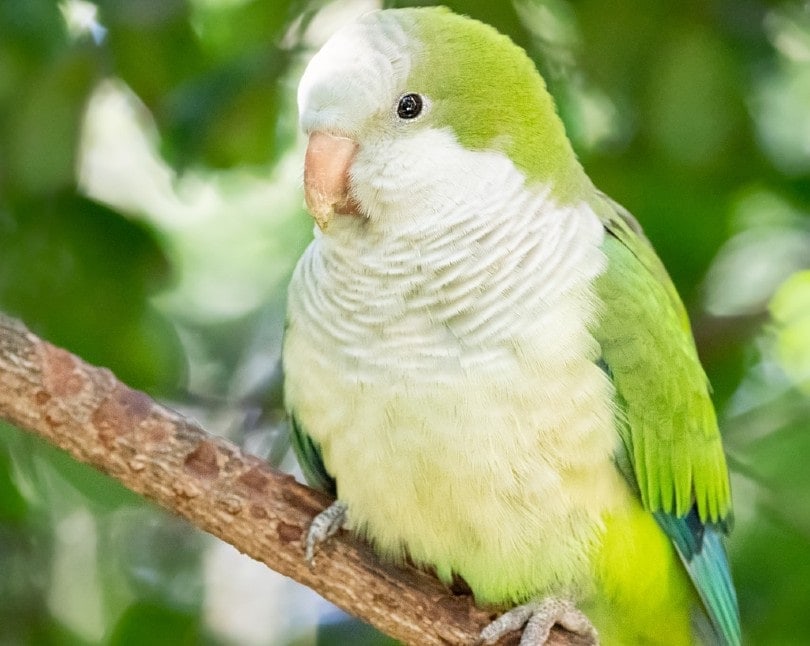
| Geographic Range | Argentina, South America |
| Size | Medium |
| Care Level | Easy to moderate |
The Quaker or Monk Parakeet is an anomaly on our list because you may not be able to have one in some places. Argentina and the surrounding countries are the native lands of the domestic bird’s wild counterpart. However, introduced populations also exist in Europe and the United States, thanks to their adaptive nature.
This medium-sized parrot is an excellent talker and quite friendly if handled regularly. It’s also long-lived, living up to 30 years old with proper care and nutrition. It can be destructive if you give it free rein in your home, making toys a necessity for this pet.
7. Nanday Conure

| Geographic Range | South America |
| Size | Medium |
| Care Level | Moderate |
The Nanday Conure is a striking bird with beautiful green plumage and a contrasting black mask. It’s a species that grabs your attention not only for its looks but for its vocalizations. This bird has a lot to say. Like other parrots, it has a varied diet of seeds, nuts, and fruits. It’s a sociable creature, forming large flocks in its native habitat in South America.
The Nanday Conure is also an introduced species with small populations in Florida, California, and Puerto Rico. It’s an intelligent species that requires mental stimulation to keep it occupied and quiet. It’s another long-lived bird, living up to 30 years under the proper conditions.
8. Sun Conure
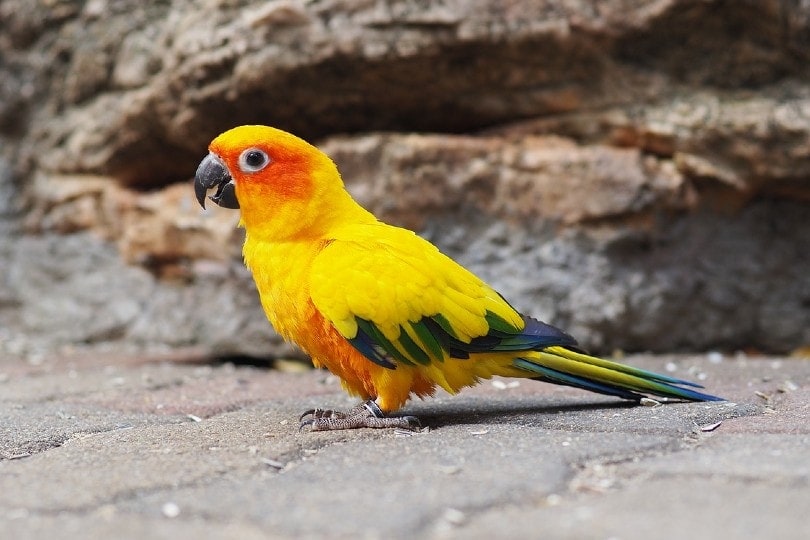
| Geographic Range | Brazil, Guyana |
| Size | Medium |
| Care Level | Moderate |
The Sun Conure is probably one of the most beautiful tropical pet birds you’ll ever see. Its gorgeous yellow, orange, and green plumage is hard not to notice. As you may expect, its beauty has made it a popular choice among enthusiasts. Its sweet personality makes this species even more endearing. It’s an intelligent bird that thrives with regular handling.
It is an active bird that requires space to fly in an aviary. The Sun Conure will enjoy free time outside its cage, although you should supervise playtime. It can be vocal at times, making toys necessary to keep it busy.
9. Jenday Conure
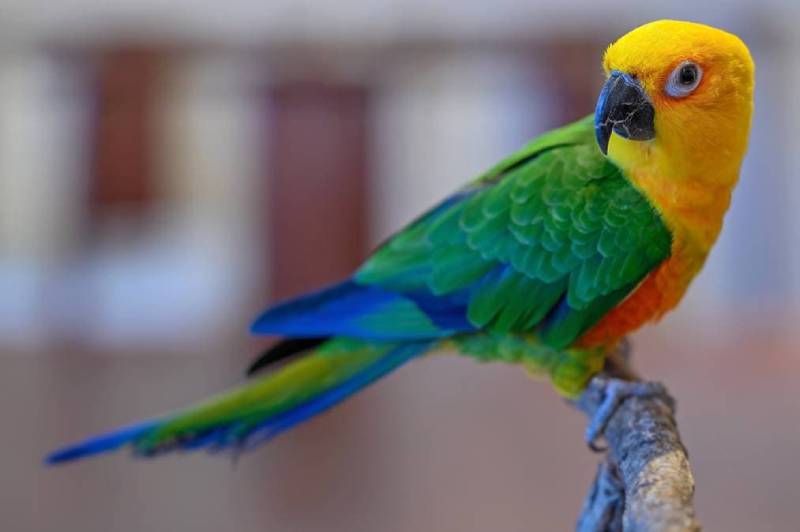
| Geographic Range | Brazil |
| Size | Medium |
| Care Level | Moderate |
The Jenday Conure looks similar to our last entry, although it doesn’t have nearly as much yellow plumage. It’s not endangered, but the species has a little range in the forests of Brazil. The bird shares many of the traits of other conures, being social, vocal, and intelligent. This one is probably the most laid-back of the bunch.
While its care isn’t as much as a parrot, the Jenday Conure fares best with plenty of time outside its cage and interacting with you. You should also offer your pet fruits, such as mangos and berries, to add variety to its diet.
10. Rose-breasted Cockatoo

| Geographic Range | Australia |
| Size | Medium |
| Care Level | Moderate |
The Rose-breasted Cockatoo is a well-adapted bird in its native Australia. It’s not unusual to see this species hanging around in town or on farms. It’s a striking bird on several fronts. Its coloring is unique and a stark contrast to the greens and yellows you may associate with parrots. It’s also an intelligent animal that makes its presence known with its loud squawking.
Owning a Rose-breasted Cockatoo is a commitment. While it’s not as cuddly as others in its genus, it can become attached to you with frequent handling. However, you shouldn’t ignore a pet that has bonded with you.
11. Sulfur-crested Cockatoo
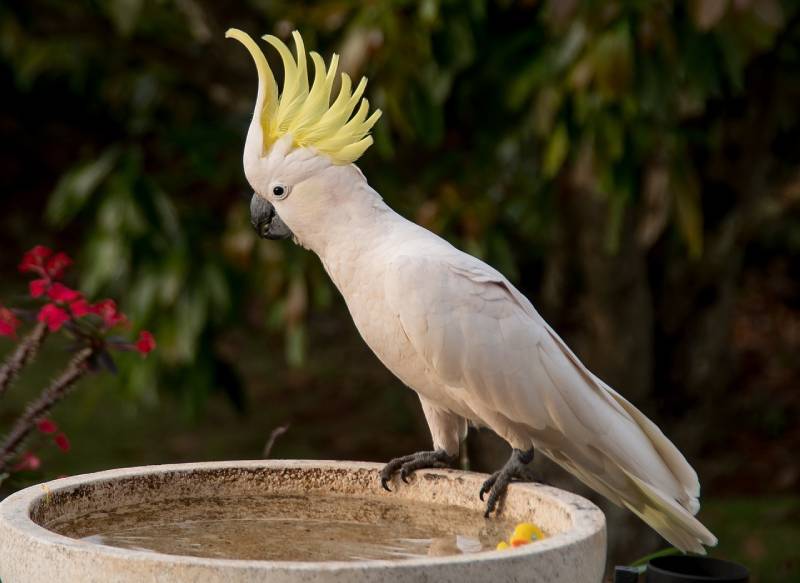
| Geographic Range | Australia |
| Size | Large |
| Care Level | Advanced |
The Sulfur-crested Cockatoo is the largest member of its genus, Cacatua, which is enough to make you take notice. It’s a beautiful bird that is all white except for its yellow crest. It’s also one of the cutest and friendliest pets you can own. The cockatoo can learn to talk easily, although it can also scream occasionally.
The advanced care level denotes how needy this bird can become. It’s affectionate and will readily bond with its owner. However, it’s also unpredictable, yet it isn’t mean. The other consideration is its intelligence. These birds are so clever that many think they are a nuisance because of their penchant for raiding garbage cans. And you thought raccoons were bad.
12. African Grey Parrot
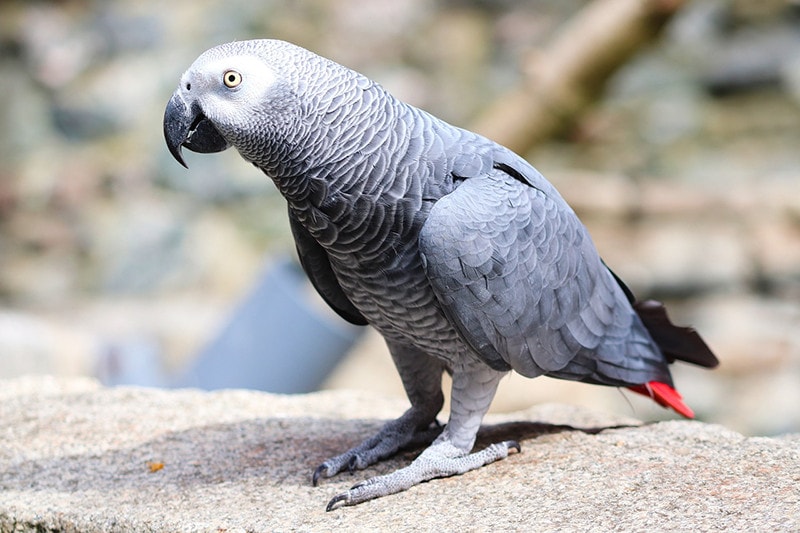
| Geographic Range | West and Central Africa |
| Size | Large |
| Care Level | Moderate to advanced |
What the last entry has in intelligence, the African Grey Parrot supersedes it with its talking ability. This bird can build quite the vocabulary if you work closely with it. Interestingly, pet owners report that their word usage appears to be in context with the things happening around them and the meanings of what they say. The species has had a long association with humans, which may explain this ability.
The parrot is entirely gray except for its white face. Three subspecies exist, differing in size and home ranges. It typically lives in savannas and grasslands. The bird fares well on a varied diet of seeds, nuts, fruits, and vegetables.
13. Amazon Blue-fronted Parrot

| Geographic Range | Northern half of South America |
| Size | Large |
| Care Level | Moderate to advanced |
The Amazon Blue-fronted Parrot is one of many species with the place as a part of its name. The variations between some may seem slight at first glance. This bird is mainly green, which you’d expect from an animal in this area. The blue refers to its forehead, which has a colorful light patch of the hue on it. The other interesting feature is the yellow rings around its eyes.
This parrot is an excellent choice for experienced pet owners. It’ll make you laugh with its antics and endear itself to you with its charm. Its native land is the forests of the northern half of South America. It is a gregarious species living in large flocks. Wild birds often call to each other in the morning and sunset, a habit your pet will likely have, too.
14. Blue and Gold Macaw

| Geographic Range | Central and South America |
| Size | Very large |
| Care Level | Advanced |
Owning a large bird like the Blue and Gold Macaw isn’t for everyone. It’s a significant investment to buy one with all the necessary supplies. We can equate it to having a giant dog breed as a pet. Training and early socialization are imperative for an animal as intelligent as this one. There’s also its large beak and claws to consider.
The Blue and Gold Macaw is one of the most popular pet birds. Its personality is as bold as its coloration. While it’s a very sweet animal, it’s also a loud one, making it unsuitable for apartment dwellers. The macaw can learn to talk and do tricks easily. It’s an excellent way to bond with your pet. Supervised playtime is a must with these curious but destructive chewers.
15. Hyacinth Macaw
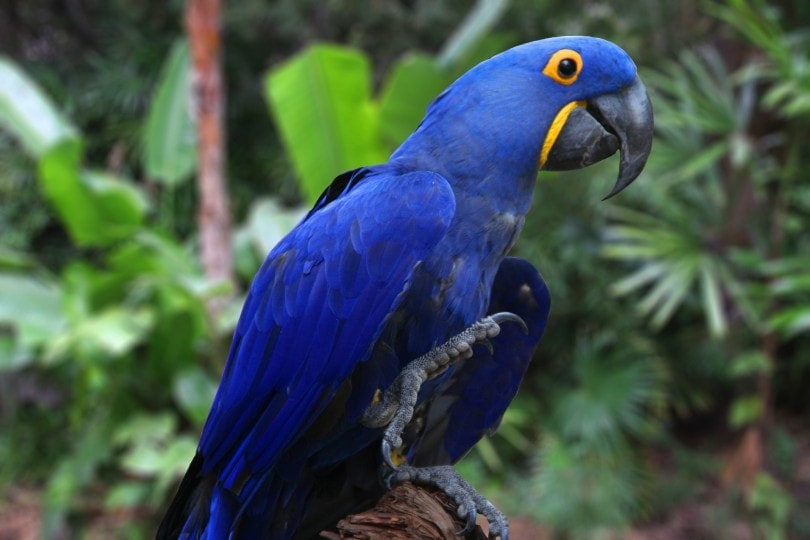
| Geographic Range | Central portion of South America |
| Size | Very large |
| Care Level | Advanced |
The Hyacinth Macaw is the largest parrot you can get. It’s easy to see why this bird is so popular. It’s nothing short of gorgeous with its dazzling blue plumage. Sadly, its beauty has also contributed to its decline. Only an estimated 4,300 individuals still exist in the wild, making it a vulnerable species. Habitat loss has also been a contributing factor.
Expect to pay a hefty price for a Hyacinth Macaw. In return, you’ll get a gentle, affectionate pet that is truly a lifelong bond. While it is vocal, it’s not as much of a screamer as some other birds on our list. Like all parrots, owning a macaw is a responsibility since socialization is essential for having a well-behaved pet.
Things to Consider Before Buying a Tropical Bird
It’s essential to remember that pet ownership is a responsibility. No one should bring any animal into their home unless they are willing to spend the time and effort to care for it. The first consideration is housing. It must be big enough to give the bird adequate space to fly and live. It’ll also require daily cleaning to ensure your pet stays healthy.
Birds require mental stimulation just like any other animal. That means toys and regular handling if you want a tame bird. Sadly, pets that get bored often take out their frustration on themselves and pluck their feathers. Remember that birds can provide a rewarding experience if you take the time to bond with them.
The other main consideration is longevity. Many species can live decades if you provide the proper conditions. When you bring a parrot or macaw into your home, it’s literally a lifelong commitment. You should research the bird’s personality and behavior. They are social animals, with many being quite vocal. That isn’t an issue with a canary, but it’s a different story with a macaw.
Conclusion
Tropical birds make delightful pets when raised in the right conditions. Whether you have a flock of finches or a single parrot, it’s essential to understand what your pet needs to stay healthy and happy. Remember that birds are intelligent animals that need companionship and mental stimulation. In return, you’ll have a pet that will entertain you with its songs or antics.
See also:
Featured Image Credit: Rutpratheep Nilpechr, Pixabay


